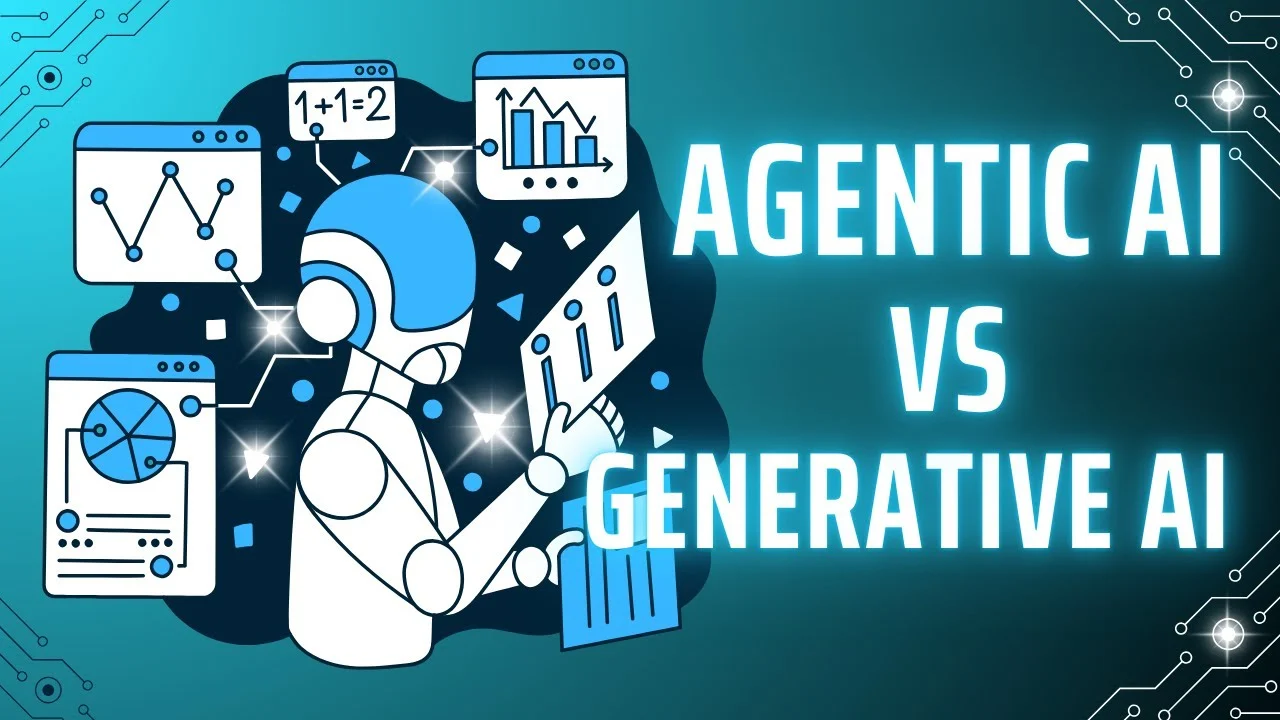Artificial Intelligence (AI) is undergoing rapid evolution, with significant shifts from narrow applications to more sophisticated and capable systems. What began with specific tasks like image recognition has transformed into advanced technologies capable of generating text, images, and even making decisions. As AI continues to advance, two distinct branches—Generative AI and Agentic AI—have emerged. These technologies are revolutionary but operate in fundamentally different ways. Understanding their differences is crucial for businesses, developers, and users to navigate AI’s future.
What is Generative AI?
Generative AI refers to AI models designed to create new content rather than simply processing existing data. Unlike traditional AI that focuses on tasks like classification or prediction, Generative AI learns patterns from vast amounts of data and uses this knowledge to produce original outputs. These outputs can include text, images, music, video, and more. Powered by advanced machine learning algorithms, particularly transformers and diffusion models, generative AI has made great strides in mimicking human creativity.
READ MORE: Aga Khan IV, Spiritual Leader of the Ismaili Muslims, Passes Away at 88
How It Works
Generative AI leverages deep learning techniques to train on large datasets, with models learning to predict outputs based on patterns they’ve encountered. For example, GPT-3 generates human-like text by predicting the next word based on the context of previous words.
Examples of Generative AI
- GPT-3 and GPT-4: Capable of writing essays, creating code, answering questions, and even composing poetry.
- DALL·E and MidJourney: Generative models that create realistic images based on textual descriptions.
- Jukedeck and MuseNet: AI systems that can generate music based on user input like genre or mood.
Use Cases for Generative AI
- Content Creation: AI tools like GPT-3 make content generation faster and more efficient, aiding in writing blog posts, product descriptions, and social media content.
- Design: AI is revolutionizing design, assisting in creating artwork, logos, fashion designs, and even predicting trends.
- Entertainment: AI-generated music, scripts, and video game characters enhance creativity and interactivity.
- Healthcare: AI accelerates drug discovery and medical research by generating synthetic data to simulate medical scenarios.
Limitations of Generative AI
- Bias: Can perpetuate biases in training data, leading to problematic outputs.
- Quality Control: Generated content may be irrelevant or nonsensical, especially with ambiguous inputs.
- Lack of Context: AI often lacks true understanding, leading to inaccurate responses.
- Ethical Concerns: The potential for generating fake content, like deepfakes or misinformation, raises ethical questions.
What is Agentic AI?
Agentic AI focuses on autonomous decision-making and problem-solving. These AI systems interact with their environment, make decisions, and take actions based on their understanding of a situation. Unlike generative AI, Agentic AI doesn’t just create content—it performs tasks, adapts to new scenarios, and learns through experiences.
How It Works
Agentic AI typically uses reinforcement learning (RL) and planning algorithms to make decisions in dynamic environments. In RL, an AI agent is trained by taking actions, receiving feedback, and adjusting its actions to optimize performance. Agentic AI systems continuously learn and adapt based on their interactions with the environment.
Examples of Agentic AI
- Autonomous Vehicles: Self-driving cars that navigate traffic, avoid obstacles, and optimize routes.
- Robots: Robots in manufacturing or service industries that perform tasks autonomously.
- AI for Gaming: In video games, AI adjusts game difficulty and responds to player actions in real time.
- Healthcare Decision Support: AI systems that help in making patient care decisions by analyzing medical data.
Use Cases for Agentic AI
- Autonomous Vehicles: Self-driving cars use agentic AI to navigate and make decisions without human input.
- Supply Chain Management: AI optimizes inventory levels, predicts demand, and automates fulfillment.
- Customer Service: Virtual assistants and chatbots provide personalized support and automate customer interactions.
- Robotics in Manufacturing: Autonomous robots in factories boost productivity and maintain quality in production.
Limitations of Agentic AI
- Complexity: The algorithms are computationally expensive and complex, making deployment challenging.
- Ethical Decision Making: Determining the ethical principles for agentic AI remains a major concern, particularly in high-stakes decisions.
- Unpredictability: In dynamic environments, agentic AI can behave unexpectedly due to unforeseen variables.
- Accountability: Determining who is responsible for AI’s decisions in case of poor outcomes is a challenge.
Generative AI vs. Agentic AI: Key Differences
Both Generative AI and Agentic AI are groundbreaking but operate in fundamentally different ways.
- Core Functionality:
- Generative AI is designed to create content, excelling in creativity, marketing, and media production.
- Agentic AI focuses on decision-making, problem-solving, and autonomous task execution.
- Application Areas:
- Generative AI: Primarily used in content creation, design, art, writing, and entertainment.
- Agentic AI: Applied in robotics, autonomous systems, customer service, and strategic decision-making.
- Technological Foundations:
- Generative AI relies on deep learning models, particularly transformers and diffusion models.
- Agentic AI uses reinforcement learning, planning algorithms, and real-time interaction with its environment.
- Limitations:
- Generative AI faces issues with bias, quality control, context, and ethical misuse.
- Agentic AI struggles with complexity, unpredictability, ethical decision-making, and accountability.
Will Generative AI and Agentic AI Converge?
The future of AI may see a convergence of Generative AI and Agentic AI, with hybrid systems combining elements of both. For example, a robot powered by agentic AI could use generative models to create contextually appropriate responses or designs. These hybrid systems could revolutionize industries like healthcare, education, and entertainment.
Ethical and Regulatory Considerations
Both Generative and Agentic AI raise important ethical and regulatory questions. Generative AI’s potential for creating fake content and Agentic AI’s decision-making capabilities in high-stakes scenarios require careful oversight. As these technologies advance, responsible AI practices, transparency, and accountability will be essential to shaping a positive future.




